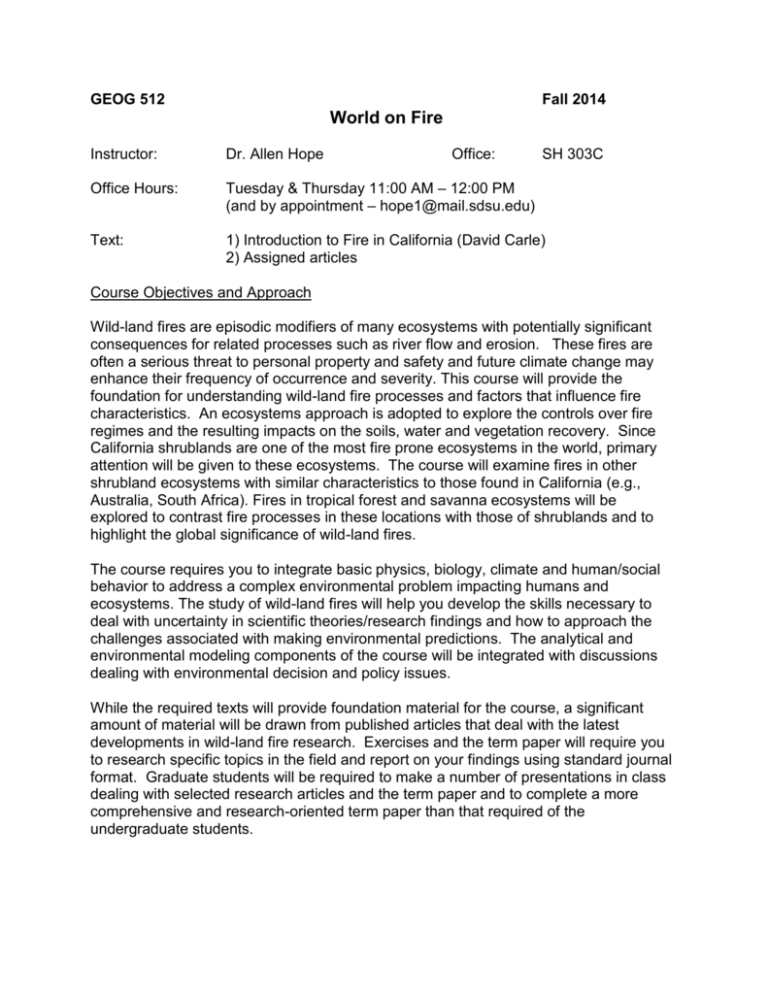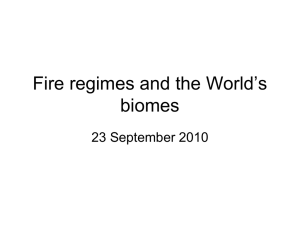View/Open
advertisement

GEOG 512 Fall 2014 World on Fire Instructor: Dr. Allen Hope Office: SH 303C Office Hours: Tuesday & Thursday 11:00 AM – 12:00 PM (and by appointment – hope1@mail.sdsu.edu) Text: 1) Introduction to Fire in California (David Carle) 2) Assigned articles Course Objectives and Approach Wild-land fires are episodic modifiers of many ecosystems with potentially significant consequences for related processes such as river flow and erosion. These fires are often a serious threat to personal property and safety and future climate change may enhance their frequency of occurrence and severity. This course will provide the foundation for understanding wild-land fire processes and factors that influence fire characteristics. An ecosystems approach is adopted to explore the controls over fire regimes and the resulting impacts on the soils, water and vegetation recovery. Since California shrublands are one of the most fire prone ecosystems in the world, primary attention will be given to these ecosystems. The course will examine fires in other shrubland ecosystems with similar characteristics to those found in California (e.g., Australia, South Africa). Fires in tropical forest and savanna ecosystems will be explored to contrast fire processes in these locations with those of shrublands and to highlight the global significance of wild-land fires. The course requires you to integrate basic physics, biology, climate and human/social behavior to address a complex environmental problem impacting humans and ecosystems. The study of wild-land fires will help you develop the skills necessary to deal with uncertainty in scientific theories/research findings and how to approach the challenges associated with making environmental predictions. The analytical and environmental modeling components of the course will be integrated with discussions dealing with environmental decision and policy issues. While the required texts will provide foundation material for the course, a significant amount of material will be drawn from published articles that deal with the latest developments in wild-land fire research. Exercises and the term paper will require you to research specific topics in the field and report on your findings using standard journal format. Graduate students will be required to make a number of presentations in class dealing with selected research articles and the term paper and to complete a more comprehensive and research-oriented term paper than that required of the undergraduate students. Evaluation Undergraduate Exam 1 Exam 2 Exam 3 Paper 25% 30% 35% 10% Graduate 25% 30% 30% 15% ** ** Graduate students will also make presentations The exams will contain questions requiring answers in written paragraph format. You should be prepared to apply the concepts you learn in class to problems. It is your responsibility to provide answers that are clear and respond directly to the questions. 1. All written exercises are to be typed. 2. You are required to work independently on class exercises. 3. No make-up exams (unless absence supported by documentation). 4. Graded exams will be reviewed in class. This is the only time to review your exam. Exam dates (dates may change) Exam 1 Exam 2 Exam 3 September 25 October 30 December 9 Exam returned December 11 at 8:00 AM GEOG 512 Fall 2014 RESPONSIBILITIES & RECIPE FOR SUCCESS RESPONSIBILITIES 1. Take responsibility for your own success or failure to achieve the desired outcome in this course. 2. Ask questions in class and be sure that you understand the concepts. Attempt to answer questions in class; you may see them again sometime. This also helps me to identify material that is not clear. Material is reviewed at the start of every class and not in a “review session”. 3. To be able to do 1 & 2, you need to attend every class. 4. Read the text sections before the associated lecture. 5. Prepare for exams well in advance. I generally use paragraph-type questions that focus on your understanding and ability to apply information. 6. Use my office hours/appointment throughout the semester to get clarification or material re-explained. 7. Take good notes in class, material will come from a variety of sources. GROUND RULES These are intended to ensure a professional and courteous environment for everyone in the class: 1. No eating or drinking (water OK) in class and no electronic devices. 2. Class starts promptly at 9:30 AM and since entering the classroom once the class has started is disruptive, please do not enter after classroom after 9:30 AM. Your continued enrolment in the class is contingent upon adhering to this requirement. 3. You are responsible for letting me know if material is not clear and needs to be reexplained. (NOTE: 1 and 2 constitute disruptive behavior). DIABILITY SERVICES If you are a student with a disability and believe you will need accommodations for this class, it is your responsibility to contact Student Disability Services at (619) 594-6473. To avoid any delay in the receipt of your accommodations, you should contact Student Disability Services as soon as possible. Please note that accommodations are not retroactive, and that accommodations based upon disability cannot be provided until you have presented your instructor with an accommodation letter from Student Disability Services. Your cooperation is appreciated. GEOG 512 Fall 2014 COURSE OUTLINE Course Outline I. Fundamentals of Wild-Land Fires A. Physics and chemistry of fire B. Ignitions C. Fuels D. Weather and terrain E. Spread over landscapes II. Vegetation and Fires A. Shrublands B. Forests C. Grasslands D. Urban Interface (Fire regimes, fuel characteristics, ignition sources, vegetation adaptations to fire) III. Effect of Fires on Soils and Water Resources A. Soils B. Water IV. Fires in Chaparral and Other Mediterranean-Type Ecosystems A. Chaparral 1. Fuel characteristics 2. Soils 3. Water 4. Recovery patterns B. South Africa 1. Characteristics of shrubland ecosystems 2. Fire and vegetation recovery characteristics C. Europe 1. Characteristics of shrubland ecosystems 2. Fire and vegetation recovery characteristics V. Fires in California Parks A. Yosemite B. Yellowstone C. Human intervention VI. Fires in the Amazon Basin A. Human drivers 1. Economic 2. Government policy B. Ecosystem characteristics 1. Vegetation and climate 2. Natural fire regimes C. Modified fire regimes VII. Fires in Savanna Ecosystems A. Africa 1. Human drivers 2. Soils and water B. Kruger National Park case study 1. Fire regimes 2. Experiments and management 3. Consequences for animals VIII. Human Response (**Fouad) A. Fire Risk B. Field Methods C. Remote Sensing 1. During fire events 2. Post-fire D. Geographic Information Systems E. Fire Databases F. Fire spread models 1. Model inputs and structure 2. Uncertainty and limitations 3. Applications G. Climate Change 1. Effects on climate 2. Driver of fire regimes




